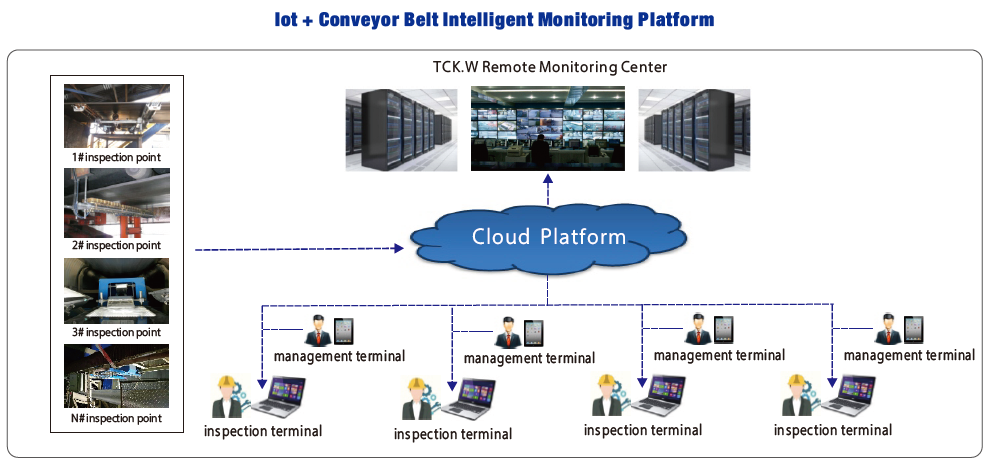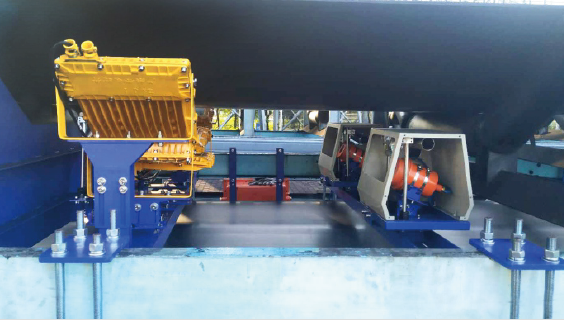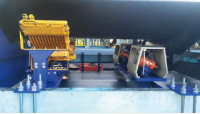
Steel Cord Conveyor Belt Smart Inspection Expert System
After TCK. W system is installed in the main belt of a mine, the problems
such as unreliable manual inspection, occupying production time and
wasting inspection energy consumption are completely solved, which
not only ensures the operation safety of the conveyor belt, but also
creates huge economic benefits.
TCK. W system can perform the inspection at the same time of
production, saving an average of one hour of inspection time per week,
transporting more 67200 tons of raw coal every year than before,
increasing the profit by 8.736 million Yuan, saving 432000 kW/h of
equipment operating energy consumption used for conveyor belt
inspection every year, and the system can also accurately evaluate the
flaws development trend of conveyor belt, and the large data quantitative
maintenance basis is provided to realize the early diagnosis of safety
hazards of conveyor belt and extend the service life of conveyor belt.
- Information




The Mechanism of Transverse Broken Belt
MONITORING SYSTEM FOR CONVEYOR BELT TRANSVERSE BROKEN BELT
The broken belts all occur at the splice and there are no exceptions to the case of broken belts at home and abroad.
The splice of conveyor belt is the weakest part of the whole belt that can endure the lowest compressive strength.
There are many reasons for splice breakage: incorrect coating, wrong pressing temperature or pressure, corrosion of steel cord
ends, severe scratches, strain, etc. Regardless of which cause of the splice damage or broken, it must be accompanied by an increase
in the amount of deformation in the splice area and the occurrence of steel cord twitch.
After the local steel cord twitch in the splice area, the entire working load will be concentrated on the non-twitch steel cords.
With the passing of time, the number of locally twitched steel cords increases and the area continues to expand. The plastic deformation
of the joint becomes larger and larger, and the rigidity and strength become lower and lower. Finally, when the range of the twitched
steel cords in the splice and its deformation increase to a certain degree, the bonding layer between the steel cord and the rubber
encounters serious damage, and when the bonding force is not enough to withstand the working load, all the steel cords were pulled
out bare, forming a splice fracture.
Main Functional Parameters
1. Transverse broken belt monitoring function:
24h×365d online real-time automatic monitoring
2. Inspection speed: 0-8m/s
3. Splice positioning accuracy rate: 100%
4. Measurement uncertainty of joint steel cords displacement: ±2mm
5. Broken cords qualitative accuracy rate: >99%
6. Quantitative uncertainty of broken cords number: ± 1
7. Location accuracy of flaw point:Ordinate length uncertainty: <1‰
Abscissa length uncertainty :<10mm
8. Splice recognition accuracy: 100%
9. Major hidden danger real-time alarming and belt halt response time: <1s
10. Temperature: -20℃~60℃; Humidity:≤95%RH
11. Ingress protection: IP67
12. Historic data query function
13. System remote debugging and diagnostic function
14. Safety Certificate:Coal mining safety certificate, explosion-proof certificate


Many steel wire ropes are arranged longitudinally inside the conveyor belt to increase their tensile strength and effectively prevent
the transverse tearing of the conveyor belt. However, the longitudinal strength of the conveyor belt has not been improved, so that the
longitudinal tear accidents often occur.
The main reasons for longitudinal tear are as follows:
1. Tear caused by deviation: when the side of the conveyor belt has a large deviation, it will form folds or wrinkles on this side, and the
conveyor belt will be scratched or scuffed by uneven tension and cause tearing.
2.Tearing caused by material jamming: generally occurs in the lower part of the chute. The distance between the front edge of the
chute and the conveyor belt is limited, the buffer rollers under the conveyor belt are distributed at intervals, and the strength of the
belt bearing force is uneven. If a large piece of sharp material is stuck between the conveyor belt and the chute, it will cause tearing.
3. Tear caused by foreign body puncture: there is a certain height difference between the two relay conveyor belts. If the sharp foreign
objects mixed in the material are too long, the conveyor belt will penetrate and be stuck on the support roller, causing tear.
. Conveyor belt longitudinal tear recognition accuracy:
Main Functional Parameters
1 Longitudinal tear length: ≤20mm;Transverse split width: ≤1mm
2. Applicable belt width:800-2400mm
3. Processing rate:80000*2048 pixel/s
4. Image resolution: 1.0mm×1.0mm
5. Video camera lateral visual field: 800-2800 mm
6. Monitoring speed: 1-8m/s
7. Image identification time: <0.1s
8. Longitudinal tear alarming response time: <1s
9. Flaw positioning accuracy uncertainty: 0.1m
10. Line array camera line frequency: 80 kHz
11. Light source normal service life: >30000h
12. Ingress protection: IP 57
13.Environment temperature: -20℃∼60℃; Humidity: ≤95%RH
14. Safety certificate:Coal mining safety certificate, Explosion-proof certificate




